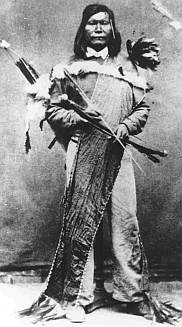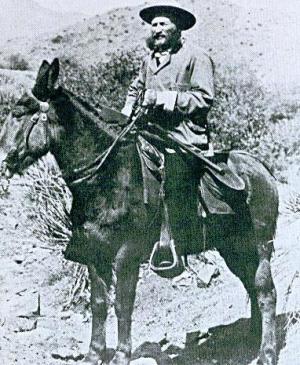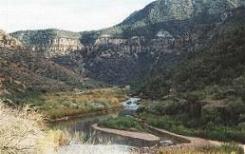
George R. Crook was a career United States Army officer who served in the American Civil War and the Indian Wars. He is best known for commanding U.S. forces in the 1886 campaign that led to the defeat of the Apache leader Geronimo. As a result, the Apache nicknamed Crook Nantan Lupan, which means "Grey Wolf."

The Sioux Wars were a series of conflicts between the United States and various subgroups of the Sioux people which occurred in the later half of the 19th century. The earliest conflict came in 1854 when a fight broke out at Fort Laramie in Wyoming, when Sioux warriors killed 31 American soldiers in the Grattan Massacre, and the final came in 1890 during the Ghost Dance War.
The Bannock War of 1878 was an armed conflict between the U.S. military and Bannock and Paiute warriors in Idaho and northeastern Oregon from June to August 1878. The Bannock totaled about 600 to 800 in 1870 because of other Shoshone peoples being included with Bannock numbers. they were led by Chief Buffalo Horn, who was killed in action on June 8, 1878. After his death, Chief Egan led the Bannocks. He and some of his warriors were killed in July by a Umatilla party that entered his camp in subterfuge.
The Snake War (1864–1868) was an irregular war fought by the United States of America against the "Snake Indians," the settlers' term for Northern Paiute, Bannock and Western Shoshone bands who lived along the Snake River. Fighting took place in the states of Oregon, Nevada, and California, and in Idaho Territory. Total casualties from both sides of the conflict numbered 1,762 dead, wounded, or captured.

The Paiute War, also known as the Pyramid Lake War, Washoe Indian War and the Pah Ute War, was an armed conflict between Northern Paiutes allied with the Shoshone and the Bannock against settlers from the United States, supported by military forces. It took place in May 1860 in the vicinity of Pyramid Lake in the Utah Territory, now in the northwest corner of present-day Nevada. The war was preceded by a series of increasingly violent incidents, culminating in two pitched battles in which 79 Whites and 25 Indigenous people were killed. Smaller raids and skirmishes continued until a cease-fire was agreed to in August 1860; there was no treaty.

The Apache Scouts were part of the United States Army Indian Scouts. Most of their service was during the Apache Wars, between 1849 and 1886, though the last scout retired in 1947. The Apache scouts were the eyes and ears of the United States military and sometimes the cultural translators for the various Apache bands and the Americans. Apache scouts also served in the Navajo War, the Yavapai War, the Mexican Border War and they saw stateside duty during World War II. There has been a great deal written about Apache scouts, both as part of United States Army reports from the field and more colorful accounts written after the events by non-Apaches in newspapers and books. Men such as Al Sieber and Tom Horn were sometimes the commanding officers of small groups of Apache Scouts. As was the custom in the United States military, scouts were generally enlisted with Anglo nicknames or single names. Many Apache Scouts received citations for bravery.

The Battle of Turret Peak occurred March 27, 1873 in the Arizona Territory between the United States Army and a group of Yavapai and Tonto Apaches as part of Lieutenant Colonel George Crook's campaign to return the natives to reservations.
The 1st Nevada Cavalry Battalion, or the Nevada Territory Cavalry Volunteers, was a unit raised for the Union army during the American Civil War. It remained in the west, garrisoning frontier posts, protecting emigrant routes, and engaged in scouting duties. The unit was disbanded in July 1866.

The Battle of Salt River Canyon, the Battle of Skeleton Cave, or the Skeleton Cave Massacre was the first principal engagement during the 1872 Tonto Basin Campaign under the command of Lieutenant Colonel George Crook. It was part of the Yavapai War from 1871 to 1875 against the Yavapai people, a Native American tribe in Arizona.

Fort Harney was a United States Army outpost in eastern Oregon in the United States. It was named in honor of Brigadier General William S. Harney. Fort Harney was used as a supply depot and administrative headquarters from 1867 to 1880 during the Army's campaign against Northern Paiute bands in Eastern Oregon and the Bannock uprising in the same area. Today, nothing remains of Fort Harney except a small cemetery.

Chief Paulina or Pahninee was a Northern Paiute war leader noted for his successful guerrilla tactics. He is known to have been active from 1859 until his death in 1867.

The Battle of Infernal Caverns was a battle during the Snake War fought between Native Americans and the U.S. Army. The Native American warriors had made a fortress out of lava rocks in the Infernal Caverns of northern California near the town of Likely. From there they were able to pour a steady fire upon the soldiers commanded by Lt. Col. George Crook. Crook's men attacked on the second day. Despite heavy casualties they managed to scale the cliffs and take the fortifications. Colonel Crook reportedly shot down Chief Sieto himself. Fighting continued into the night as the Native warriors withdrew deeper into the caverns. Crook commented, "I never wanted dynamite so bad as I did when we first took the fort and heard the diabolical and defiant yells from down in the rocks". On the third day the Natives had fled the caverns.
The Battle of Cookes Spring was a skirmish which took place between Apache raiders and the United States Army on March 9, 1857. Apache raiders were tracked through the frontier by a party of U.S. Army cavalry who intercepted the native warriors at Cooke's Spring in the Black Range of New Mexico.

The Battle of Pecos River was fought in 1864 during the Navajo Wars. United States Army troops and Apache Scouts defeated a force of Navajo warriors next to the Pecos River in New Mexico. It is notable for being one of the many Indian war battles involving the California Column.
The Battle of Steen's Mountain was a battle during the Snake War. In response to Paiute attacks in Idaho, Lt. Col. George Crook led a punitive expedition into southeast Oregon, defeating Chief Howluck at the Battle of Owyhee River. Continuing his pursuit, Crook again encountered the Chief Paunina's Paiute village at Steen's Mountain. As Crook ordered the charge, his horse bolted and carried him through the native village. Nevertheless, his men followed. Despite several close calls for Crook personally, his troopers' fire was accurate and inflicted heavy casualties. A month later Crook's men engaged in one final skirmish before Crook ended the expedition due to bad weather.

The Crow War, also known as the Crow Rebellion, or the Crow Uprising, was the only armed conflict between the United States and the Crow tribe of Montana, and the last Indian War fought in the state. In September 1887 the young medicine man Wraps-Up-His-Tail, or Sword Bearer, led a small group of warriors in a raid against a group of Blackfoot which had captured horses from the Crow reservation. Following the raid, Sword Bearer led his group back to the Crow Agency to inform the Indian agent of his victory, but an incident arose which ended with the young leader taking his followers into the mountains. In response, the United States Army launched a successful campaign to bring the Crow back to the reservation.

Pawnee Scouts were employed by the United States Army in the latter half of the 19th century. Like other groups of Indian scouts, Pawnee men were recruited in large numbers to aid in the ongoing conflicts between settlers and the Native Americans in the United States. Because the Pawnee people were at war with the Sioux and Cheyenne and had been under constant pressure and aggression by those tribes, some of them were more than willing to serve with the army for pay. A number of Pawnee served between 1864 and 1871. They were armed with rifles, revolvers and were issued scout uniforms.

Numaga was a Paiute leader during the Paiute War of 1860 that centered on Pyramid Lake in what is now Nevada in the United States. The war was caused by an influx of miners and ranchers after silver was discovered in the Comstock Lode near to Carson City. The newcomers assaulted the Paiutes and destroyed their foods supplies. When the Paiutes responded, the U.S. Army used force to suppress them. Both before and after the war, Numaga was a strong advocate of peace and did much to reduce the violence on both sides. He died of tuberculosis, a "white man's disease", in 1871.
Louis Henry Marshall (1827–1891) was a native of Virginia, a U. S. Army officer on the frontier in the Antebellum Period, in the American Civil War and in the Snake War.












